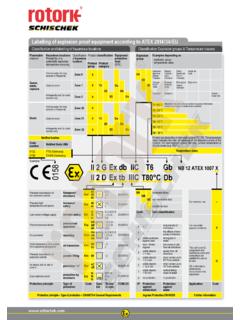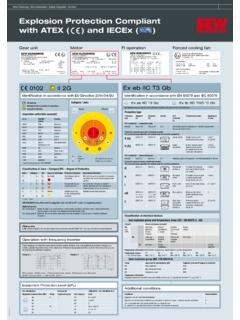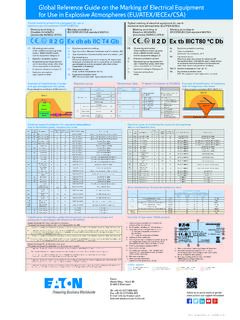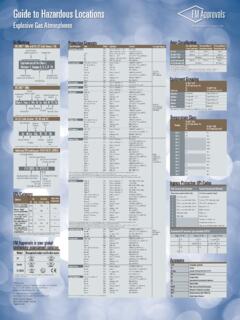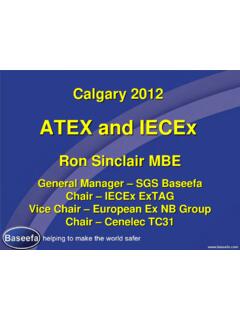Transcription of ATEX Markings Explained - LCM Systems
1 ATEX/IECEx Markings Explained To comply with ATEX/IECEx regulations, all equipment and protective Systems that are used in hazardous areas must be marked legibly and indelibly with a specific set of letters/numbers. Together, these letters/. numbers specify the exact criteria that a product meets in relation to those ATEX/IECEx regulations, and so determines the type of environments that they are safe to operate in. LCM Systems Certificate Markings Ingress Protection Protection Concepts Level Equipment group Temperature (table 6).
2 (table 1) (table 3). Classification Gas - G (table 5). Dust - D. Technical Information Sheet Gases II 2 G Ex d IIC T6 Gb IP6x Tamb -20 C to +55 C. Dusts II 2 D Ex tb IIIC T85 C Db IP6x Tamb -20 C to +55 C. Explosion Proof Ambient Temperature ATEX Category Sub-group (table 2) (table 4) Range Equipment Protection Level (tables 1 & 3). Table 1 - Equipment Groups There are two equipment groups - Group I, which concerns mines and is very restrictive due to the highly volatile methane gas and dusts present, and Group II, which relates to all other above ground industries.
3 Equipment Groups Equipment Equipment Atmosphere Level of Required Protection Equipment Group Category Protection Type Ignition Performance &. (ATEX) Level Protection Operation Gas Dust I MI Ma Ma Methane & Dust Very High Two faults, remain energised & functioning I M2 Mb Mb Methane & Dust High Severe normal operation, de-energise in explosive atmosphere II 1 Ga Da Gas, Vapour, Mist, Dust Very High Two faults II 2 Gb Db Gas, Vapour, Mist, Dust High One fault II 3 Gc Dc Gas, Vapour, Mist, Dust Low Normal operation LCM Systems .
4 Solutions in Load Cell Technology ATEX/IECEx Markings Explained Table 2 - ATEX Category There are three area category types, with Category 1 requiring a very high level of protection and defined as an area having a permanent or prolonged risk of explosions (Zone 0), Category 2 which requires a high level of protection and has a frequent risk of an explosive mix being present in the air (Zone 1), and Category 3, specified as requiring a normal level of protection with a small chance of an explosive mix forming (Zone 2).
5 Area Classification Equipment Category Definition Zone Gases & Dusts Vapours Category 1 An area where an explosive atmosphere is Zone 0 Zone 20. present continuously or for long periods (over 1000 hours per year or >10% of the time). Category 2 An area where an explosive atmosphere is Zone 1 Zone 21. likely to occur in normal operation (10 - 1000 hours per year or to 10% of the time). Category 3 An area where an explosive atmosphere is not Zone 2 Zone 22. likely to occur in normal operation (under 10 hours per year or 0 to of the time).
6 Note: Category 2 certification also covers the lower category 3. Table 3 - Protection Concepts Protection concepts refer to the means of ensuring a piece of equipment being used in a hazardous area does not cause an explosion. There are four basic methods utilised to avoid uncontrolled ignitions - exclusion of the flammable substance, prevention of component sparks or hot surfaces, explosion quenching and energy limitation. By applying individually or in combination, the protection concepts listed below are applied to a product in order to achieve this.
7 Protection Concepts - Electrical Equipment for gases, vapours & mists (G). Symbol Equipment Indicative Zones Standard Basic Concept of Protection Type of Protection Protection (EN/IEC). Level Optical radiation Op pr Gb 1, 2 60079-28 Protected by shutdown, enclosure Op sh Ga 0, 1, 2 60079-28 or inherently safe OP is Ga 0, 1, 2 60029-78. Increased safety e Gb 1, 2 60079-7 No sparking parts or hot surfaces type n' (non- nA Gc 2 60079-15. Technical Information Sheet sparking). Flameproof d Gb 1, 2 60079-1 Contains the pressure, quench the flame Type n' (enclosed nC Gc 2 60079-15 Contains the pressure, quench the break) flame Quartz/ q Gb 1, 2 60079-5 Quench ignition Sand filled LCM Systems .
8 Solutions in Load Cell Technology ATEX/IECEx Markings Explained Table 3 - Protection Concepts (continued). Symbol Equipment Indicative Zones Standard Basic Concept of Protection Type of Protection Protection (EN/IEC). Level ia Ga 0, 1, 2 60079-11 Limit the potential ignition energy Intrinsic safety ib Gb 1, 2 and surface temperatures ic Gc 2. Pressurised px Gb 1, 2 60079-2 Keeps the flammable gas out py Gb 1, 2. pz Gc 2. Type n' (sealing & nC Gc 2 60079-15. hermetic sealing) nR Gc 2. Type n' (restricted breathing).
9 Encapsulation ma Ga 0, 1, 2 60079-18. mb Gb 1, 2. mc Gc 2. Oil immersion o Gb 1, 2 60079-6. Protection Concepts - Electrical Equipment for dusts (D). Equipment Standard Type of Protection Symbol Protection Indicative Zones (EN/IEC). Basic Concept of Protection Level Enclosure ta Da 20 60079-31 Dust tight enclosure, limited surface tb Db 21 temperature tc Dc 22. Intrinsic safety ia Da 20 60079-11 Limit the potential ignition energy ib Db 21 and surface temperatures. May add ic Dc 22 ingress requirements Encapsulation ma Da 20 60079-18 Keep the flammable dust out mb Db 21.
10 Mc Dc 22. Pressurised pD Db 21 60079-4 Protection by pressurisation of Dc 22 enclosure Note: tb (Zone 21) certification also covers the lower tc classification (Zone 22). Technical Information Sheet LCM Systems . Solutions in Load Cell Technology ATEX/IECEx Markings Explained Table 4 - Gas Sub-divisions The ATEX standard also has a classification for explosive gases and dusts, with Group I referring to methane gases and coal dust (mining), while Group IIA to IIC gases and Group IIIA and IIIC dusts (above ground industries)


